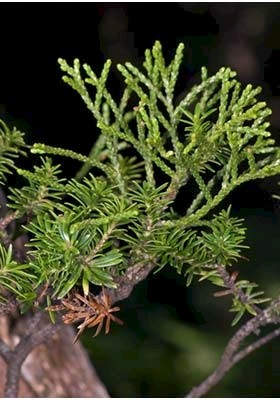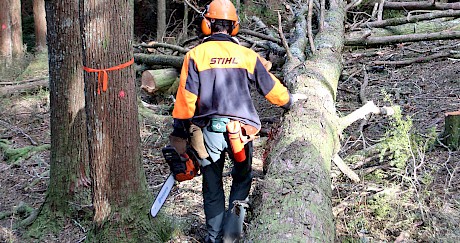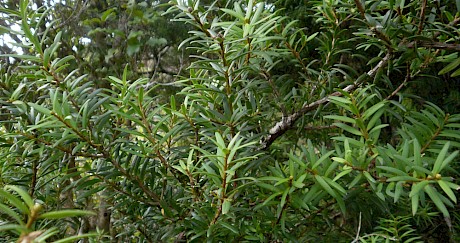Pink Pine (Halocarpus biformis)
 (also known as Yellow Pine and Alpine Tar wood)
(also known as Yellow Pine and Alpine Tar wood)
History
Pink pine was known as Dacrydium biforme until 1982 when a new Genus, Halocarpus, was established for three Dacrydium species, including pink pine.
Pink pine does not appear to have a Maori name, which suggests that it was little used by them; possibly because it grew in places they did not often visit. It was however used by early settlers for fence posts, sleepers and house blocks.
Distribution
Halocarpus biformis is a small tree with spreading branches and a rounded crown. In exposed places, eg, alpine areas, it often forms a tight, rounded, cypress-like shrub. Bark is silver-grey, peeling away in small thick flakes to reveal a reddish-brown inner layer. It has quite a wide distribution but is scattered and restricted to sub alpine sites in the North Island - from latitude 39° South, although Wardle states its northernmost location is on Moehau, at latitude 36° 35’, in the Coromandel Ranges. (He gave no reference for this but his source must have been a paper by L B Moore, published in Tāne in 1973.) On the southern slopes of Mt Ruapehu it is found occasionally in the forests and above the bush line around bogs with Halocarpus bidwillii. In the south it is commonest in Westland and Otago, especially the Catlins but mostly above 300 metres. It grows down to sea level in Stewart Island and is typically found on low fertility, poorly drained sites in high rainfall areas. On more fertile sites it grows into a small tree.
Pink pine is not regarded as threatened because it is relatively widespread and frequent in the South and the population is not declining.
Tree size and growth
On good sites it grows up to 10 metres tall and one metre diameter. Growth rate is very slow on most sites and Wardle states that trees can reach the age of over 1000 years. It has been used in dendrochronological studies. Although no trial data is available, it will probably grow much faster on more fertile sites.
Timber and other uses
No measured timber characteristics are available for pink pine. The timber is yellowish brown in colour, sweetly perfumed and straight grained with great strength and durability. It is easily worked and is a useful turnery timber, although with little figure. It is possibly the most durable of New Zealand native woods. With rimu and some other closely related podocarps it is an important food for kakapo.
The most important economic value of Halocarpus biformis is that it contains the highest level of the bicyclic diterpenoid, manool; more than any other plant – 6 to 8% dry weight. Manool can be converted into ambreinolide, a constituent of ambergris, very important in the manufacture of perfumes. There have been several attempts to produce manool from the timber of H biformis, it being estimated that there would be enough timber on the West Coast to produce 20 tonnes of manool annually for 25 years. However as most of the available supply grows on land administered by the Department of Conservation it would seem that a supply from natural forests is precluded. A few years ago a firm in Otago was extracting manool from pink pine logs and exporting it to the United States. Currently the southern Iwi, Ngāi Tahu, are investigating potential utilisation, based on traditional cultural practice.
Damaging agencies
Pink pine is a hardy species and no information on fungal diseases or insect attack has been found. The name tar wood suggests the tree is highly resinous and this makes it very prone to fire damage.
Potential
The species is worthy of study because of its high manool content and its durability. As far as is known there have been no attempts to grow pink pine commercially for any purpose.
Research requirements
Pink pine should grow quite fast on moist, well drained, fertile soils and trials are needed to determine whether this is so and what growth rates might be. Also, if it grows faster, will the 6-8% dry weight level of manool be altered? Reasonably moist and fertile sites in the Central North Island may be suitable for trials. Wardle suggests that propagation (as with rimu) should be straightforward. Propagation trials to date have probably been with seed. Because seed production is known to be irregular, propagation by cuttings from young plants should be investigated.
References
- Allan H H 1961. Flora of New Zealand Vol. 1 Government Printer Wellington
- Brooker S G, Cambie R C & Cooper R C 1988. Economic Native Plants of New Zealand. Botany Division, D.S.I.R
- Dawson J, Lucas R & Connor J 2011. New Zealand’s Native Trees. Craig Potton Publishing
- Farjon A 2001. World Checklist and bibliography of Conifers (2nd ed) Royal Botanical Gardens, Kew
- Moore L B 1973. Botanical notes on three high peaks overlooking the Hauraki Gulf. Tane 19: 213 - 220.
- Norton DA & Palmer JG 1992. Dendroclimatic evidence from Australasia. In: Bradley RS, Jones PD (eds) Climate since AD 1500. Routledge, London pp 463–482
- Wardle J 2011. Wardle’s native trees of New Zealand and their story. NZ Farm Forestry Assn & Bateson Publishing
- Ngai Tahu Reference http://www.ntrc.canterbury.ac.nz/documents/Shannon%20Goldsmith%20presentation.pdf
Species profile by Ian Barton


